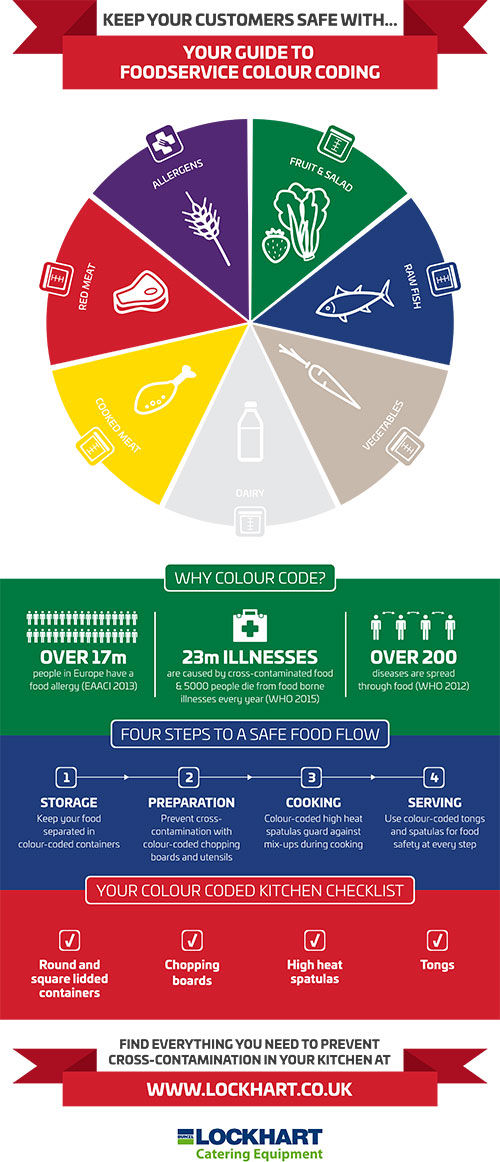FREE DOWNLOAD: Your Guide To Foodservice Colour Coding

The Food Service Agency (FSA) offers extensive advice on how to prevent cross-contamination in your kitchen as part of an effective Hazard Analysis and Critical Control Program (HACCP) system, and introducing colour-coding into your kitchen makes it even easier for you to do so. Having dedicated and colour-coded food storage and preparation tools for specific types of foods helps you to ensure the safety of your customers against foodborne illnesses, by keeping foods separated at every key stage of your food flow – from storing, right through to serving.
Understanding colour coding in your kitchen
At Lockhart Catering Equipment we have an outstanding choice of colour-coded kitchen equipment to choose from, including colour-coded chopping boards, utensils such as high heat spatulas and tongs, and food storage containers. The FSA does not dictate which colours should be used for particular types of foods in a commercial kitchen environment, but certain colours are already in common use.
Below you can find our ultimate guide to foodservice colour coding, in the form of a handy poster which shows which colours we recommend for the various types of food. Why not download and print it to display in your kitchen as a daily reminder for your staff on how to follow a colour coding system, and the reasons why it’s so important to do so?
Our recommended colours for colour coding:
• GREEN – Fruit and salad
• BLUE – Raw fish
• BROWN – Vegetables
• WHITE – Dairy
• YELLOW – Cooked meat
• RED – Red meat
• PURPLE – Allergens (e.g. gluten)
As over 17 million people in Europe have a food allergy (EAACI 2013) it is important to consider how you control allergens during your food preparation process. Purple has been widely adapted as the designated colour for allergens in commercial kitchens, and with utensils such as purple tongs and spatulas that can withstand high heats available to buy online at Lockhart, it’s easy to become more allergen-friendly in your restaurant and give your customers peace of mind when they dine with you.
Why use colour coding in your kitchen?
There are many reasons why introducing a colour coding system into your restaurant or foodservice business kitchen is a great idea. These include:
• Being simple for all staff to understand and follow visually, which is especially important if English is not their first language
• Clearly designating areas of your kitchen for the preparation of particular types of food
• Playing an important role in managing allergens in your kitchen, as well as food-borne diseases
• Making it easy for you to trace the source of contamination if colour-coded items are found outside of their designated area
• Being flexible to the needs of your kitchen, so you can use only the colours that are relevant to the foods that you prepare
• Impressing FSA inspectors and auditors by showing your commitment to preventing cross-contamination in your kitchen and compliance with HACCP
• Being a cost-effective system to implement as you simply replace the products that you already use every day.
In short, adapting a colour-coding system in your restaurant kitchen or foodservice business is one of the easiest steps you can take to ensuring the safety of your food and the health of your customers.
Have you already adapted a foodservice colour-coding system in your restaurant kitchen, or is it part of your business plans for 2017? Tell us in the comments below or tweet us @BunzlLockhart, and share with us any more tips that you have for implementing colour-coding in your foodservice business.




Leave a comment